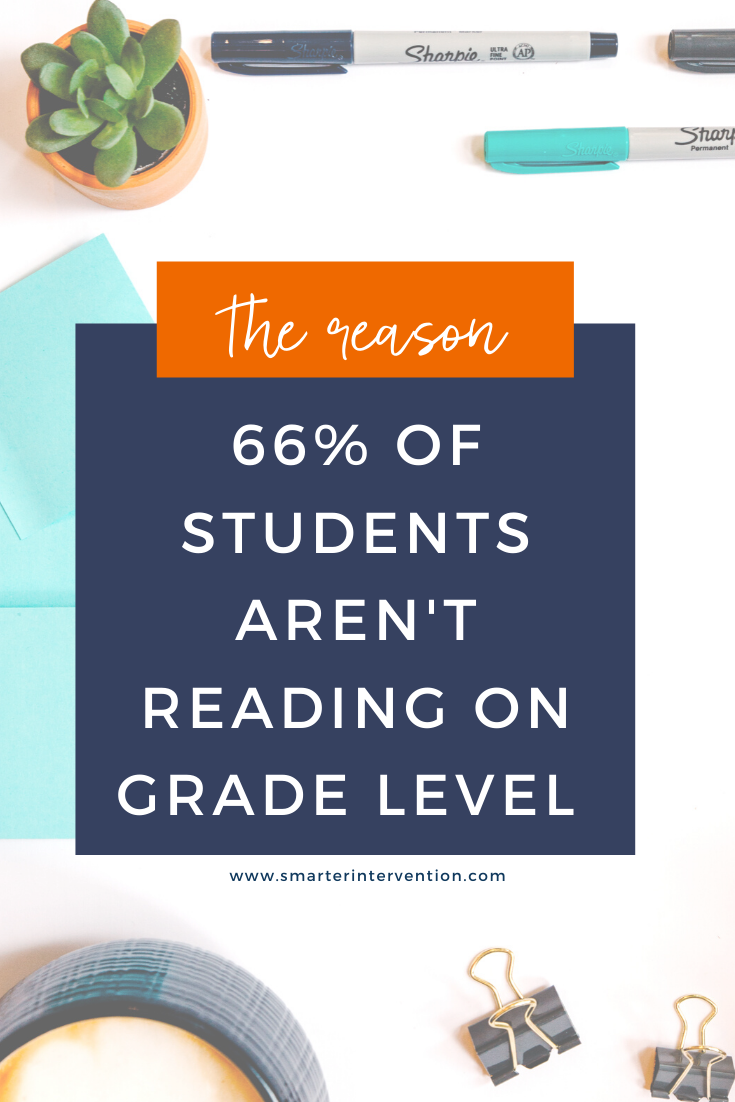The Reason 66% of Students Aren't Reading on Grade Level
Hi friends,
Last week we talked about how in our office, we often get really fired up when it comes to our students and supporting the educators that serve them.
“We’re not yelling, we’re just passionate” has become a common saying as we try our best to share what we’ve learned working with students and from the research with all of you.
Before we jump into this week’s blog, we wanted to make a disclaimer.
Last week, we opened the conversation around the fact that 66% of 4th-grade children are not reading at grade level, according to the US Department of Education in 2019.
Let us be clear -
In no way, whatsoever, are we pointing the fingers at teachers (general education or special education) or those in the school working with these students every day. As we dig into the reasoning behind why students are continuing to struggle, we know that you are doing EVERYTHING and more that you can for these kids and more often than not are spending every bit of energy and time trying to help them.
Their struggles are not your fault. We are not, and will not, ever place blame on the educators. Instead, we need to look at the systems and processes put in place that are not allowing educators to receive the support, materials, and training needed to effectively close the gap for these students.
Over the next few weeks, we are going to look at why 66% of children are not reading at a proficient level by the 4th grade and uncover how we can change this trajectory for them.
Let’s start by looking at the why.
Why are 66% of children not reading at a proficient level by the 4th grade?
When we discussed this statistic with the team - it got heated. If you know us at all, then you know that we believe every child deserves success and the fact that two-thirds of them are not able to access grade-level materials is gut-wrenching. We did some digging and realized the reason that 66% of 4th-grade students are not reading at grade level is that…
…students are falling through the cracks at every level of our Tiered Support System.
Here in the United States, students are often placed into different “tiers” based on their abilities to perform at what is considered grade level. In the graphic below, we have broken down what this looks like in a general classroom.
The students at the top of the diamond are our “Tier 3 students.” These students (outlined in red) are those that are considered significantly below grade level. Our Tier 2 students (orange) are those that would be considered below grade level. In teal, we have our Tier 1 Students who are considered to be on or approaching grade level, and our students in navy, at the very bottom of the diamond, are those who are considered above grade level.
At first glance, it would appear that 9 out of these 23 students are struggling (which in our opinion is already too many). Based on the description of these tiers, it looks like the students colored in red and orange are struggling but the Tier 1 students are performing at grade level and therefore, they aren’t struggling.
This is an illusion. Based on the research and the data, we have students falling through the cracks in every tier.
Over the next few weeks, we will be diving into case studies for students in each of these tiers. We will look through their data, IEP goals, progress, and more.
Before we jump into our first case study next week, we want to make sure that this point is clear.
It is not that these students cannot learn, or that teachers are doing a bad job.
Let’s say that again.
It is not that these students cannot learn, or that teachers are doing a bad job.
The fact of the matter is, that teachers have not been provided with support, materials, and resources that allow them to offer explicit, systematic, cumulative instruction in a cohesive way.
Instead of trying to pull resources from a hundred different places, these students need streamlined instruction that addresses ALL of the core components of literacy together and allows educators to easily differentiate instruction to target their specific needs.
It should not be up to the teachers to build this kind of instruction- they already have more than humanly possible on their plate.
We do, however, need to work to get these students this kind of instruction because right now these students are continuing to fall deeper and deeper through the cracks.
Without clear, aligned targets and the use of a structured & systematic approach, these students aren’t just not making growth - they are falling further and further behind.
Next week, we will start by looking at a 4th-grade student who was identified for IEP support in Kindergarten. We will look through his data and open the conversation around why he is still struggling after 4+ years of support.
If you are an educator and you are ready to change the trajectory for these kids -
(without feeling like you have to take on the world by yourself)…
…grab the Science of Reading Blueprint. This blueprint will help you understand the 3 key scientific models that drive effective literacy instruction, learn how to integrate the research into practice, and provide simple checklists that will help you weave the science of reading into your instruction.



